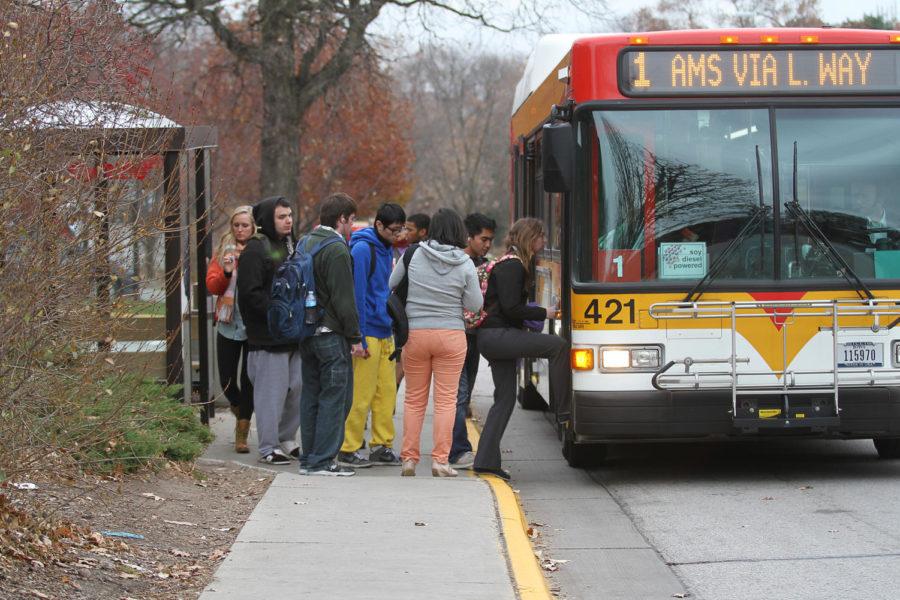Performing under pressure: CyRide looks for ways to cover costs after loss of grants, increased enrollment
Students pay a semester fee to be able to use the CyRide for free. The city of Ames, Government of the Student Body and students help fund this service.
October 20, 2014
CyRide’s problems began a few years ago when the federal government made the decision to remove all of its competitive federal grants.
These Transportation Investment Generating Economic Recovery grants gave CyRide around $2 million in federal money each year. These federal grants have now been cut for CyRide.
“The major problem to be discussed is the increase in cost due to total rides,” said Matthew Goodman, City Council at-large representative and member of the Ames Transit Agency Board of Trustees.
This loss of money is becoming very apparent on campus with bus routes filled to capacity at peak times of the day.
“You have to build your capacity to your peak. We look at the anticipated demand, and we try to increase funding so we can accommodate the demand,” Goodman said.
With around 1,500 more students on campus this year alone, the rising amount of students has added to the money problems that the transportation system is already facing.
“It has put more pressure on all of our infrastructure, including public transportation. But the thing is most communities would agree that it’s a good problem to have,” said Zach Murrell, member of the Ames Transit Agency Board of Trustees and senior in mechanical engineering.
The CyRide system is recognized as the nation’s small urban transit system with the highest number of rides per capita at 106 rides per capita.
“Really, this is an issue of being able to accommodate all of [the students]. It is nothing that’s their fault. It’s just that we have a lot of people here so we have to figure out how do we accommodate all those people,” Murrell said.
This addition of students means that CyRide must add more buses to its routes at peak times to hold all the students and also add more routes to accommodate new areas of the city.
CyRide plans to add six more buses to its fleet this coming spring, including four “bendy buses” that hold a larger amount of riders per bus, said Sheri Kyras, transit director for CyRide.
By adding more buses to the fleet, Ames’ roads endure more wear and tear. This means that more roads need to be repaired for the buses to continue running on those routes.
These areas include new apartment complexes and new additions to the college such as the Research Park.
Currently, three parties fund CyRide. The Government of the Student Body funds 63.1 percent while 25.6 percent is funded by the city. The last 11.3 percent is paid by Iowa State. These three contributors give CyRide a budget of around $6 million.
The way the funding is divided currently means that students pay for CyRide usage in three ways.
The first is directly through GSB and activity fees students pay at the beginning of the semester, the largest percentage of funding for the overall budget.
Indirectly, students pay Iowa State’s share, and the 22,000 students that live off campus also pay through taxes.
“The best way to look at it is that everyone in the community, students included, pay for access to CyRide at $1.25 a ride,” Goodman said. “The student body has it all paid for them by GSB so that impacts their usage [of the system].”
Having users realize the amount of money that goes into each ride could help with CyRide’s problems.
“The issue is that because of how [the funding] works, how GSB pays that, then people use it a lot more than they ever used it before because they aren’t receiving any price signals to conserve rides,” Goodman said.
Another solution to the problem of overcrowding may lie in the times that students use the system.
“You could just limit rides on peak hours and have unlimited rides on not peak hours to kind of push people off the peaks a little bit. This is a common concept in most transit but also in a lot of utilities.” Goodman said.
Looking at the potential funding models for the future, CyRide is taking into consideration that the rise in students may mean a rise in shares paid for by students.
“If we can’t figure out a way to pull back the usage, we will probably ask the student body to cover a little more to make up for all that increased usage,” Goodman said.
According to the student projection numbers put out by the university, the amount of students coming into the university will level out and stop growing in the next few years.
“My outlook is that I know that all those parties value CyRide. I know that they are proud of the level of service that we can give and how it benefits everyone. I’m confident that we will all come to an agreement on how to maintain CyRide,” Murrell said.
By creating a funding model and finding an agreement by all three parties involved in funding, managing the amount of students that have come to Iowa State seems possible.
“I think were doing good,” Kyras said.







